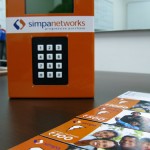India-based Simpa Networks is using a pay-as-you-go method to make solar energy affordable to people living in rural areas in that country.
After making a small down payment for a high quality solar home system, customers pre-pay based on actual energy use through their cell phone. Each small payment contributes to the final purchase price.
The Asian Development Bank announced it would make a $2 million equity investment in Simpa, which will extend the service to more than 60,000 households by 2015.
"In our launch market, India, as in most developing country markets, the low income consumer can actually afford a small solar home system if only they could pay for such a system over time, in small, irregular, and user-defined increments. That is, if the pricing model matched the pricing model they are already using for kerosene, candles, batteries, and phone charging," explains Simpa.
"We transform an energy expenditure into an asset purchase. We offer customers the opportunity for ownership of their energy resource and break their dependence on expensive, unhealthy, and inefficient sources of light and electricity," says Simpa.
To do this, Simpa developed Progressive PurchaseTM technology that can turn their solar system on or off as people make payments. The technology combines product-embedded hardware and cloud-based software.

Every time a customer makes a payment, the solar system is "unlocked" for a paid amount of energy consumption in kilowatt hours. When this prepaid consumption is exhausted, the solar home system is temporarily disabled until another payment is made. When the solar system is fully paid off, the product is permanently unlocked.
"The success of this entrepreneurial venture could lead to increased venture capital funding for inclusive business models which deliver goods and services to those at the base of the economic pyramid," says Aniruddha Patil, Investment Specialist with ADB’s Private Sector Operations Department.
People in many emerging markets earn under $10 a day and often spend 30% of their income on inefficient, dirty and expensive kerosene for lighting. That adds up to $38 billion a year for lighting and $10 billion for cell phone charging.
"There is likely a $100 billion global opportunity for small scale distributed energy solutions, with no clear market leader," says Simpa.
A solar system can meet these basic needs for $200-$400 retail, but people can’t afford to pay the full cost upfront.
These systems typically include a solar panel, battery, charge controller, at least 3-4 lighting points, a mobile phone charging port and power for charging or powering small DC devices.
Over the 10 year useful life of a quality solar system, households end up spending $1500-$2000 on kerosene, candles, batteries and phone charging, paying much more than they need to.
Other interesting approaches for getting solar to these communities are solar loans in Bangladesh, Solar in a Suitcase and a gravity-fueled light.
Here’s their website:

Hi,
I have a diary in Village Manuwas, Sohna Palwal road. I would like to use this pay as you go system for solar power. Request you to provide the details. Thanks. Pankaj